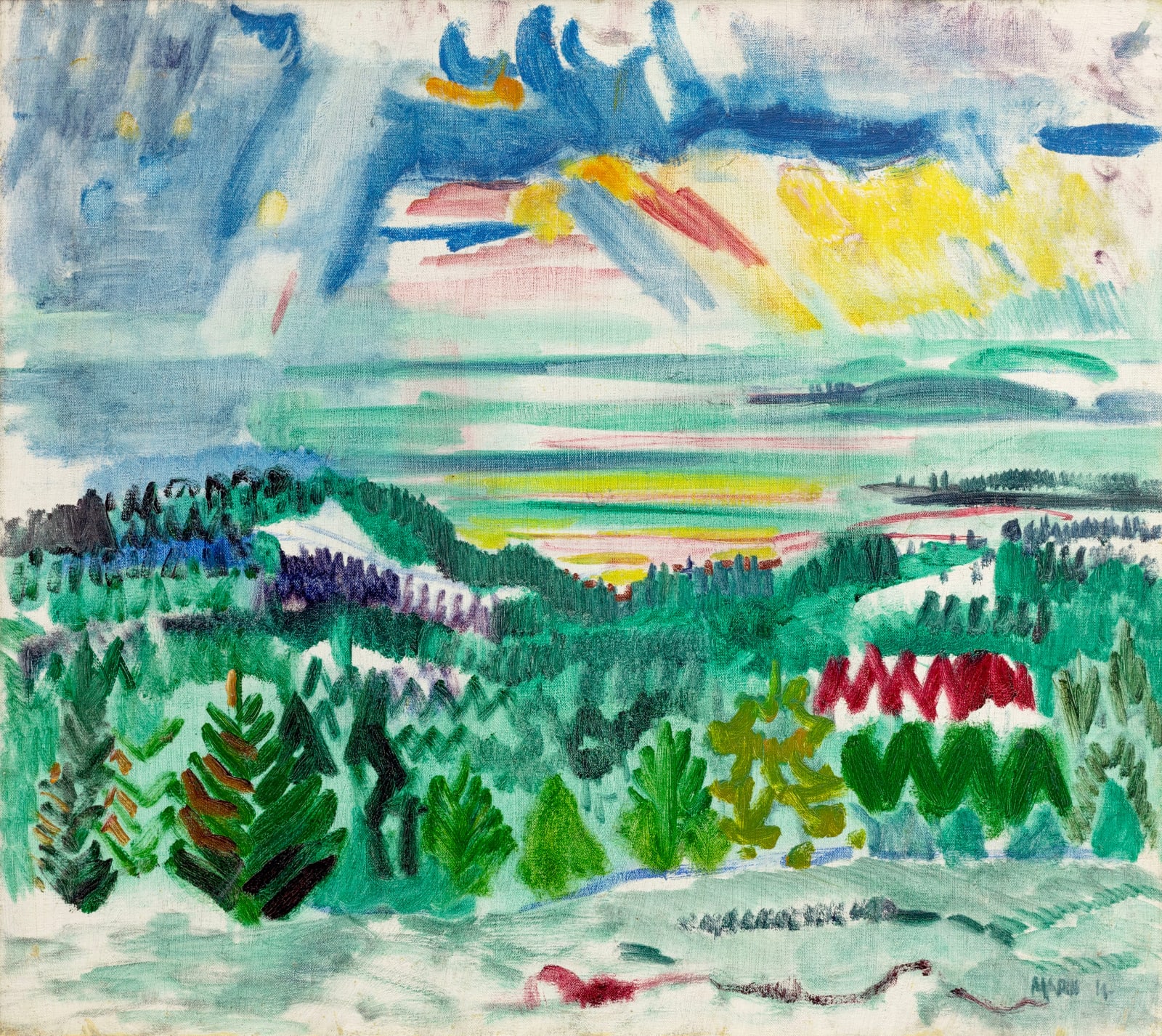-
Artworks
John Marin American, 1870-1953
Untitled (Landscape), 1914Oil on canvas22 x 25 inches
55.9 x 63.5 cmSigned and dated at lower right: MARIN 14Sold1914 marks perhaps the most significant moment in John Marin’s artistic career, as it was the summer he discovered Maine, a place that would inspire and fuel his painting for...1914 marks perhaps the most significant moment in John Marin’s artistic career, as it was the summer he discovered Maine, a place that would inspire and fuel his painting for decades. Invited by his friend and fellow artist Ernest Haskell, Marin spent this transformative summer working around Small Point Harbor on Casco Bay. By then, Marin had already established himself as one of the most commercially successful artists in the circle of renowned photographer and art dealer Alfred Stieglitz. Confident in Marin’s market appeal, Stieglitz even provided advances for Marin’s early summers in Maine, a testament to his success. While Marin was primarily known for his experimental and dynamic watercolors, the present painting represents a rare and important example of his early work in oil.
Before venturing to Maine, Marin spent the summer and fall of 1913 in Castorland, New York, creating numerous watercolors and a few oil paintings of lush foliage and wooded landscapes. The techniques and subjects from Castorland seamlessly transitioned into his early Maine landscapes. Although struck by the grandeur of the ocean, many of Marin’s early Maine works focused on wooded landscapes. Indeed, Untitled (Landscape) is topographical, depicting a sunny Maine vista overlooking a tranquil ocean. Marin’s incorporation of bare canvas, likely inspired by his watercolor practice and influenced by Fauvist works of Henri Matisse or fellow American artist Alfred Maurer, is evident. Featuring calligraphic abbreviations, pine trees appear as zigzagged triangles of color in shades of purple, green, red, and black. The sun’s warm rays sweep diagonally across the sky and form horizontal strokes on the water, while the foreground foliage showcases thick, vibrant brush marks. This calligraphic style would later evolve and become more pronounced in Marin’s works from the late 1940s. However, this early oil experimentation conveys a distinctly different mood in contrast to the majestic and tumultuous Maine coast present in Marin’s later oils. Here, the tranquil and serene sea, with its bright colors and verdant landscape, evoke spontaneity and freshness in both subject and painterly approach.
By 1914, Marin had adopted the practice of painting almost exclusively outdoors. He worked quickly, often using both hands and embracing improvisation. This spontaneity and fluidity in his technique drew parallels between music and painting. It’s fitting that this painting attracted the attention of its long-time owner, celebrated jazz and pop producer Tommy LiPuma. LiPuma, driven by his independent spirit and appreciation for modernist culture, curated an impressive collection of American art from the early to mid-twentieth century. His collection mirrored the energy and dynamism he admired in jazz, a genre characterized by its pursuit of new forms of creative expression. LiPuma saw a connection between his music career and art collection, observing:
I found many parallels between how to read music and how to read a painting. They are both compositions—even though, on the one hand, you’re talking about notes and harmony, and on the other, you’re talking about moves and structure and colors. When I’m making records, I go in and deal with different tonal colors. I have to figure out what musical textures are going to fit next to other textures, and how to mix these textures together. [1]
Marin’s Untitled (Landscape) abounds with rich structures and textures that not only showcase the artist’s early experimentation with oil, but also encapsulate a significant phase in his stylistic evolution. This phase was influenced by his discovery of Maine and the dynamic interplay between his experimentation with modernist techniques and his commitment to remaining tethered to the natural world amid the rising tides of abstraction.
[1] Tommy LiPuma, quoted in Bruce Weber, “An Interview with Tommy LiPuma,” High Notes of American Modernism: Selections from the Tommy and Gill LiPuma Collection, New York: Berry-Hill Galleries, inc., 2002, pp. 18-19
Provenance
The artist; to
The estate of the artist, 1953;
Private collection;
Tommy LiPuma, New York; to
Estate of the above, 2017Exhibitions
Kennedy Galleries, New York, John Marin's Oils, October 30-November 24, 1984, no. 3, as Landscape
The Parrish Art Museum, Southampton, New York; Norton Gallery and School of Art, West Palm Beach, Florida; The Telfair Academy of Arts and Sciences, Savannah, Georgia; Museum of Art, Pennsylvania State University, University Park, Pennsylvania; Albright-Knox Art Gallery, Buffalo, New York, Marin in Oil, July 18, 1987-September 4, 1988, no. 3, as LandscapeLiterature
Sheldon Reich, John Marin: A Stylistic Analysis and Catalogue Raisonné, Vol. II, Tucson: University of Arizona Press, 1970, p. 390, no. 14.34, illus.
Klaus Kertess, Marin in Oil, Southampton, New York: Parrish Art Museum, 1987, pp. 35-36, fig. 17a, illus. in color, p. 68, illus., as Landscape
Subscribe to our mailing list to receive updates from the gallery
* denotes required fields
We will process the personal data you have supplied in accordance with our privacy policy (available on request). You can unsubscribe or change your preferences at any time by clicking the link in our emails.

